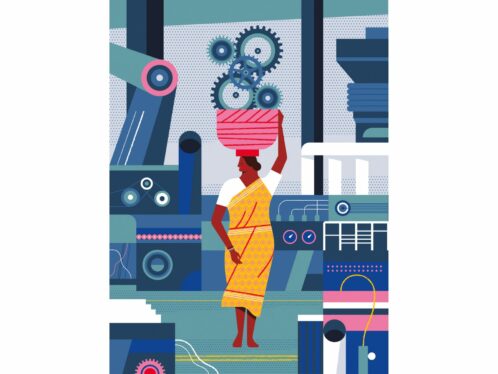
Tomorrow’s tech
The ever-accelerating pace of technological change raises questions about where we will be 25 years from now. Evolution asked two leading researchers for their insights into the future.
Long ago, nature perfected the construction of matter at the molecular level. Now mankind is producing materials and structures measured in thousandths of a micron, and products based on nanotechnology are becoming part of everyday life. Research carried out by Peter Dobson, a professor at Oxford University and director of the university’s Begbroke Science Park, and his colleagues has been commercialized in the form of more effective sunscreens and a fuel additive that creates less pollution and better fuel efficiency. Dobson believes that in the coming quarter century nanotechnology could provide a solution to what many agree is the biggest issue facing humanity – climate change. The idea is to turn CO2 from a pollutant into a fuel. “In principle this could level off climate change and maybe cause it to reverse somewhat,” says Dobson. He notes that research has reached the proof of concept stage. The process, called photocatalytic carbon dioxide conversion, would use energy from the sun, with nanoparticles as a catalyst, to convert CO2 into methane or methanol and potentially kerosene or diesel. “If we get the technology right, the potential is huge,” says Dobson. “Initially the CO2 would come from power stations via capture and scrubbing, but there are suggestions that you could harvest CO2 from the air. We are looking 20 or 30 years ahead, but I don’t see why it couldn’t work.” The 2010 Nobel Prize in Physics was awarded to Andre Geim and Konstantin Novoselov for their experiments with the two-dimensional material graphene, a form of carbon just a single atom thick. Dobson believes graphene could replace silicon in some applications and could have a huge impact on computer technology. “This has the potential to be a game changer,” he says. “Using either organic molecules or a graphene-derived entity, you could make something that begins to look like the processors in a brain.” Processing power could be increased a thousand-fold – or more. “This is the most far-fetched development in which I have some confidence, although it will take many years,” says Dobson. Dobson believes that in general technological progress over the coming quarter century will be in the form of new applications for existing technologies rather than new breakthroughs. “Being realistic,” he says, “we’ll see some of today’s clever gizmos being more widely applied, and this could have a huge impact in health care, for example. People will be able to do self-diagnosis on their iPhones without having to wait to see the doctor, for example. Because that doesn’t require a fundamentally unknown technology, it’s where the really big changes will happen.” Silicon Valley has been the birthplace of many of today’s must-have technologies, and it’s here that Mike Liebhold, a distinguished fellow at the non-profit Institute for the Future (IFTF), researches future digital technologies and how they might impact on humans. He expects two technological revolutions in the coming 25 years. The first is what he calls “supercharged interaction”, using the Internet cloud as a supercomputer. “The power of the cloud supercomputer can amplify human communications,” explains Liebhold, whose career includes positions at Apple and Intel. “For example, language translation and speech-to-text are computationally very intensive because the computer compares the sound of your voice against millions of samples. That demands very rapid parallel computing, and the cloud is ideal for this.” So, for example, in 25 years people will have online conversations with each other in different languages, leading to more fluent international collaboration, while speech-to-text will open up the Internet to preliterate peoples. The second revolution Liebhold sees ahead is the World Wide Web moving from the page to the physical world. “Instead of looking at the Web on the screens of our devices, we might be wearing eyeglasses or contact lenses that show us a richly annotated physical world,” he says. “Machines will explain themselves. You will look at a building and its history will be articulated in more detail than you care about, and as you walk down the street, you will turn on filters so you aren’t bombarded with information from every merchant.” The fact that Liebhold – who stresses that his role at IFTF is to offer foresight to customers, not to predict the future – is speaking with Evolution via Skype begs the question of how we would do the interview 25 years from now. “It’s possible using new materials that we’ll see digital displays on table tops or walls,” he says. To have a conversation with someone in another country you would walk up to a public display and, after biometric authentication using the pattern of your retina and the sound of your voice, access your digital workspace. “There will be less need to carry physical devices,” he says. “It’s being called ‘invisible computing’, where the world itself becomes digital.” Liebhold says that the key to the technologies of the future will be collaborations across the borders of different technology areas and scientific fields. “Today, there are many technologies that alone are mature enough to cause great disruption. But it is the combined effect of these new developments that will continue to accelerate the pace of technological change.” The science of small
For your information





